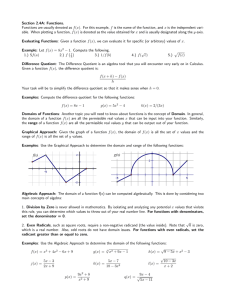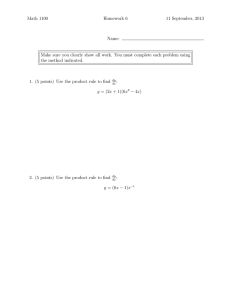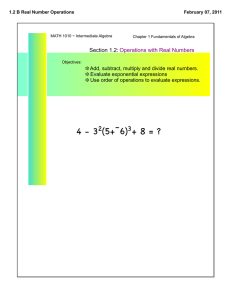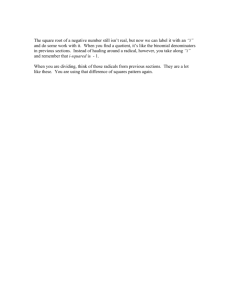Section 2.4A: Functions Functions are usually denoted as f(x). For
advertisement
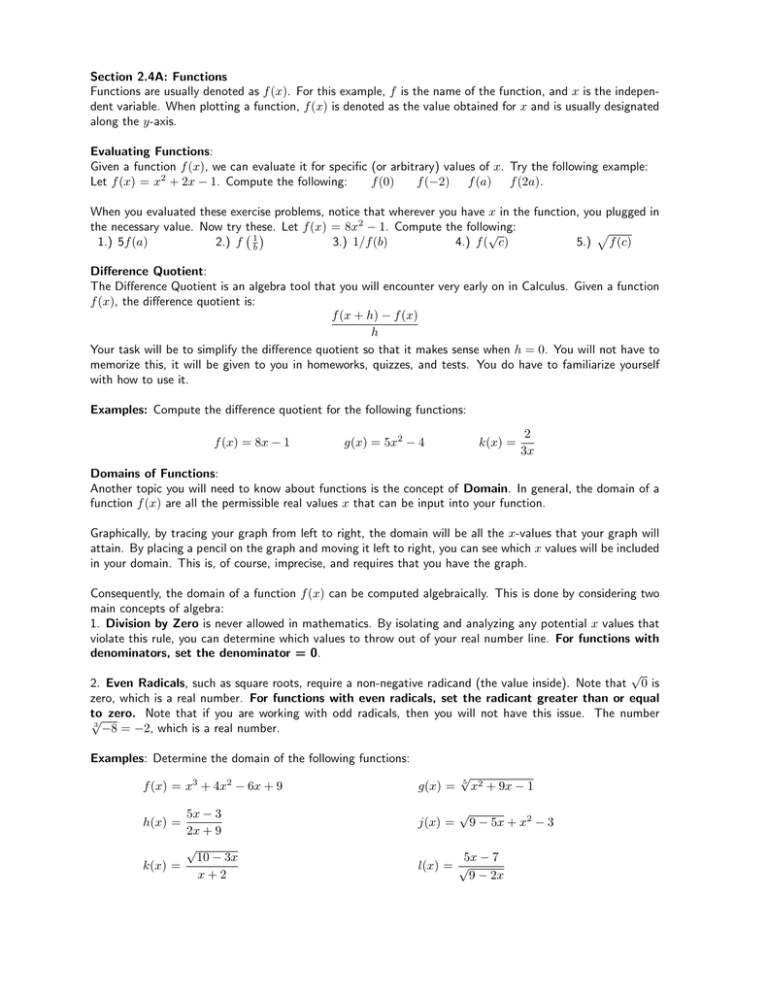
Section 2.4A: Functions Functions are usually denoted as f (x). For this example, f is the name of the function, and x is the independent variable. When plotting a function, f (x) is denoted as the value obtained for x and is usually designated along the y-axis. Evaluating Functions: Given a function f (x), we can evaluate it for specific (or arbitrary) values of x. Try the following example: Let f (x) = x2 + 2x − 1. Compute the following: f (0) f (−2) f (a) f (2a). When you evaluated these exercise problems, notice that wherever you have x in the function, you plugged in 2 the necessary value. Now try these. p Let f (x) = 8x − 1. Compute the following: √ 1 5.) f (c) 1.) 5f (a) 2.) f b 3.) 1/f (b) 4.) f ( c) Difference Quotient: The Difference Quotient is an algebra tool that you will encounter very early on in Calculus. Given a function f (x), the difference quotient is: f (x + h) − f (x) h Your task will be to simplify the difference quotient so that it makes sense when h = 0. You will not have to memorize this, it will be given to you in homeworks, quizzes, and tests. You do have to familiarize yourself with how to use it. Examples: Compute the difference quotient for the following functions: f (x) = 8x − 1 g(x) = 5x2 − 4 k(x) = 2 3x Domains of Functions: Another topic you will need to know about functions is the concept of Domain. In general, the domain of a function f (x) are all the permissible real values x that can be input into your function. Graphically, by tracing your graph from left to right, the domain will be all the x-values that your graph will attain. By placing a pencil on the graph and moving it left to right, you can see which x values will be included in your domain. This is, of course, imprecise, and requires that you have the graph. Consequently, the domain of a function f (x) can be computed algebraically. This is done by considering two main concepts of algebra: 1. Division by Zero is never allowed in mathematics. By isolating and analyzing any potential x values that violate this rule, you can determine which values to throw out of your real number line. For functions with denominators, set the denominator = 0. √ 2. Even Radicals, such as square roots, require a non-negative radicand (the value inside). Note that 0 is zero, which is a real number. For functions with even radicals, set the radicant greater than or equal to zero. Note that if you are working with odd radicals, then you will not have this issue. The number √ 3 −8 = −2, which is a real number. Examples: Determine the domain of the following functions: f (x) = x3 + 4x2 − 6x + 9 5x − 3 2x + 9 √ 10 − 3x k(x) = x+2 h(x) = g(x) = j(x) = √ 5 √ x2 + 9x − 1 9 − 5x + x2 − 3 5x − 7 l(x) = √ 9 − 2x
